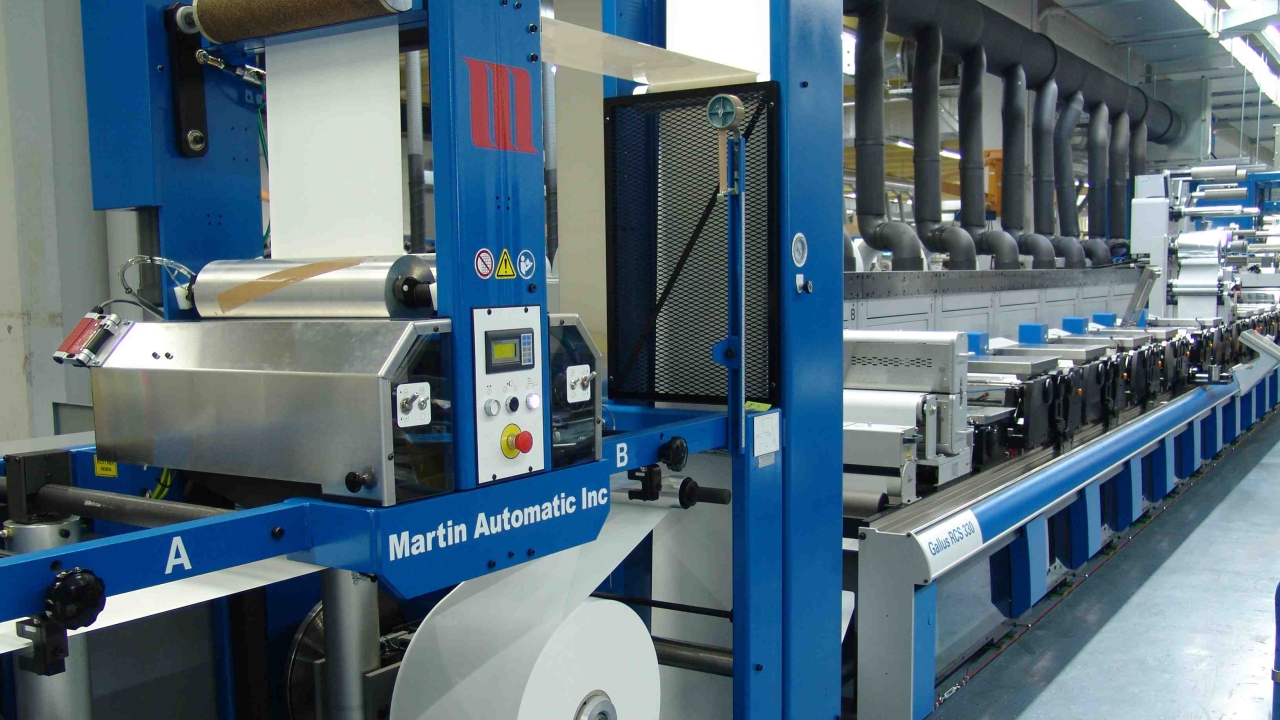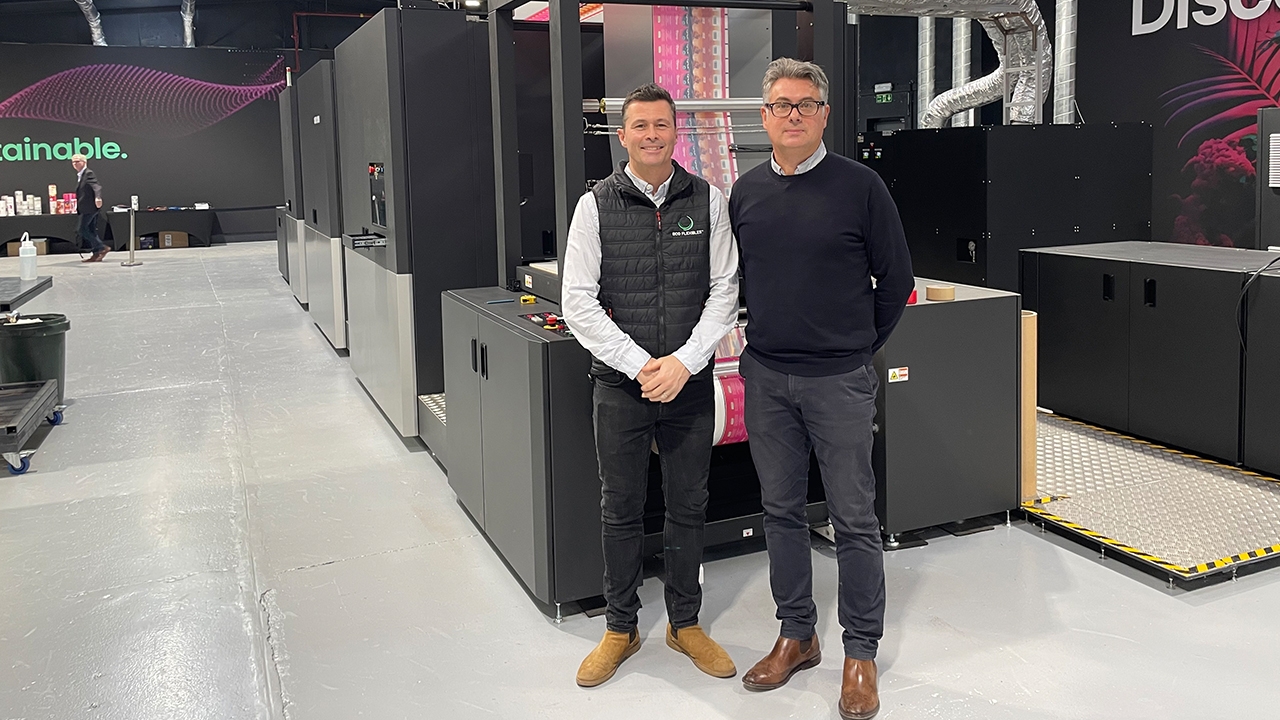Permanent revolution

Permapack has grown its business through the recession by reinventing itself as a one-stop packaging converter, supported by continued investment in automated, flexible technology. Andy Thomas reports
Against the recent tide of economic downturn and shrinking order values, Permapack, the Swiss-based packaging specialist, has been investing in technology to meet a surging demand for its high quality printed products, particularly tube laminates and other barrier films.
The shortage of production capacity came to a head towards the end of 2009, according to the company’s chief operations officer, Mark Lehmann: ‘It became obvious that we needed to invest quickly in extra capacity and were able to secure fast installation of Gallus and Martin Automatic equipment to complement our existing plant.’
The equipment in question was a fifth Gallus RCS 330 all-servo flexo press fitted with a Martin MBSF unwind/splicer and an LRD rewinder. The package of equipment exactly mirrors previous investment at Permapack’s headquarters in Rorschach, which was among the first to install Gallus’ pioneering RCS range in 2001. All bar the first two are fitted with identical Martin automated handling. ‘This is a combination that could have been designed especially for Permapack as it fits our product portfolio so well and offers us complete flexibility at the high end of the market, which is unusual,’ commented Lehmann.
The latest Gallus line features E+L edge guiding and Teknek web conditioning and Softal corona treatment, ten base units capable of accepting fully servo driven UV flexo or screen print stations, and/or hot foil (Permapack specified 10 flexo and two screen units), full Uviterno UV curing, lamination, and cold and hot foil capability. The RCS is fitted with a rotary die-cutting station with matrix rewind, while the print register control system features motorized adjustment of longitudinal, lateral and diagonal register, and a BST Powerscope 3000 web video mounted in-line for verification.
The company operates in three distinct divisions: logistics, food, and cosmetics. These market sectors generate annual sales in excess of CHF 60m, from an overall staff level of 170, of which 115 work in printing. Lehmann explains that approximately 65 percent of the logistics business is traded on a ‘buy-and-sell’ basis, mostly from Italian suppliers. The remainder of the turnover at Rorschach is produced in-house on a range of presses that now includes five Gallus RCS 330 and two Gallus EM 410 UV flexo lines. There are also Gallus letterpress lines, and older water-based Omet and Comco presses.
Format choice
‘We seriously looked at a wider web width for our most recent investment, and the Gallus RCS 430 looked attractive, but for reasons of time, availability, and interchangeable tooling, we opted to stay with the 330 mm format,’ said Lehmann. ‘Next time however, we will investigate presses with up to 600 mm web width to move our output capability to the next level.’
Lehmann described a typical Permapack job as 8-colors plus, with foil and/or screen printing. Most work is carried out to 150 lpi, and with 10-color, or 60 lpcm capacity on all bar one of the RCS lines, Permapack is set up for tube, label and flexible packaging production. All the RCS lines have exchangeable hot foil units; some have turner bars and others cold foil capacity, which allows the company to have an identical back up machine for each job.
With a growing export demand to satisfy, up from 10 percent of output in 2007 to nearer 30 percent at present, Permapack is tapping into the markets of central Europe where demand for very high quality packaging is booming, according to Mark Lehmann. From the time the company moved into filmic labels, tubes and flexible packaging in 2002, after a major loss of sales when one customer relocated its business, Permapack has never looked back. Today, it produces 20 million labels each day and processes over 10,000 jobs each year. Run lengths on flexible packaging are longer than those on labels, thus increasing volume further. Production in the first quarter of 2010 is up by 23 percent over the same period last year, Lehmann reveals.
Because Permapack specializes in longer run, high quality work, the advent of digital presses is not relevant to its present business model. ‘We are however looking closely at what digital plates could offer us, and that could well be our next investment plan,’ said Lehmann. When asked if offset technology had a part to play in Permapack’s future, Lehmann was doubtful. ‘We are already producing high quality flesh tones and vignettes with UV flexo – at least that’s what our customers tell us, so we do not feel under pressure to add offset capacity.’
Explaining the company’s development into a ‘packaging specialist’, Lehmann said: ‘It begins with full consultation with the brand owners’ design team. They tell us what they are trying to achieve and we explain how our technology can best deliver their requirements. This sets a quantifiable standard for both sides that means any repeat work exactly matches the original. From then on, it’s a process of ongoing liaison.’ With 100 percent video inspection on three of the five Gallus RCS lines, and Martin Automatic MBSF and LRD units that allow non-stop running, Permapack goes as far as possible to reduce errors.
‘We chose the Gallus/Martin combination early on as the best way to achieve repeatable quality. Five years on we have no desire to change a winning formula. In practical terms the Martin equipment saves us around 70–80 meters of substrate per 1,000 meter roll, which adds up to CHF 200,000 a year. It has also reduced our run times by around 30 percent, and by not stopping for roll changes, has improved the quality of our finished product, and that is almost priceless.’
The Martin MBSF (F for Film) unwind/splicer and LRD transfer rewind will handle reels up to 1016 mm in diameter at speeds up to 150 m/min, which are well above Permapack’s current production requirements. With production rising and substrates becoming more expensive, savings made on waste will become even more critical, and the benefit of the Martin equipment will be further reflected in bottom line performance.
With future business already showing a need for three further press lines of current size, Lehmann is keen to look at alternatives. ‘We need roll to roll with cold foil, and would like to stay with Gallus, but we will have to go to a wider web. At present we run screen and hot foil at 50–60 m/min, straight UV flexo at 80–90 m/min, and with full video surveillance some jobs up to 120 m/min – but we need more.’
In-house production currently is divided amongst the cosmetics industry (44 percent), food and beverage (36 percent), pharmaceutical (9 percent), and logistics and industrial (approximately 5 percent each). With ISO 9001:2000 and BRC/IoP accreditations, Permapack lists leading international brand owners among its customer portfolio. It's demanding, says Lehmann, and keeps Permapack up to the mark in terms of quality performance. He is quick to acknowledge the customers role in company’s success. ‘To serve the best, you need to invest in the best, from people to technology,’ he concluded.
Pictured: Gallus RCS 330 fitted with Martin MBSF unwind/splicer and LRD rewinder
This article was published in L&L issue 5, 2010
Stay up to date
Subscribe to the free Label News newsletter and receive the latest content every week. We'll never share your email address.


